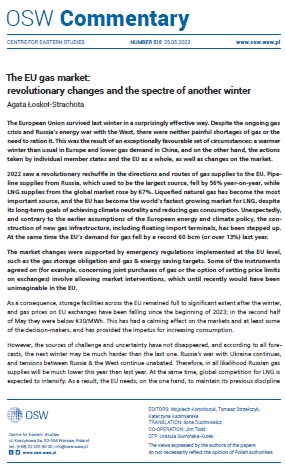The EU gas market: revolutionary changes and the spectre of another winter
The EU gas market: revolutionary changes and the spectre of another winter
Author(s): Agata Loskot-Strachota
Subject(s): Business Economy / Management, Energy and Environmental Studies, Environmental and Energy policy, Government/Political systems, International relations/trade, Political behavior, EU-Approach / EU-Accession / EU-Development, Financial Markets, Peace and Conflict Studies
Published by: OSW Ośrodek Studiów Wschodnich im. Marka Karpia
Keywords: EU gas market; The war and the reduced supplies from Russia; Russian LNG imports; rising gas prices;
Summary/Abstract: The European Union survived last winter in a surprisingly effective way. Despite the ongoing gas crisis and Russia’s energy war with the West, there were neither painful shortages of gas or the need to ration it. This was the result of an exceptionally favourable set of circumstances: a warmer winter than usual in Europe and lower gas demand in China, and on the other hand, the actions taken by individual member states and the EU as a whole, as well as changes on the market.2022 saw a revolutionary reshuffle in the directions and routes of gas supplies to the EU. Pipeline supplies from Russia, which used to be the largest source, fell by 56% year-on-year, while LNG supplies from the global market rose by 67%. Liquefied natural gas has become the most important source, and the EU has become the world’s fastest growing market for LNG, despite its long-term goals of achieving climate neutrality and reducing gas consumption. Unexpectedly, and contrary to the earlier assumptions of the European energy and climate policy, the construction of new gas infrastructure, including floating import terminals, has been stepped up. At the same time the EU’s demand for gas fell by a record 60 bcm (or over 13%) last year.
Series: OSW Commentary
- Page Count: 8
- Publication Year: 2023
- Language: English
- Content File-PDF

